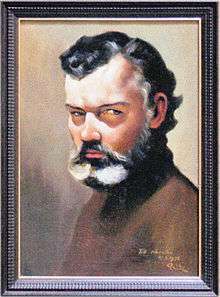Erik Schmidt (painter)
Erik Schmidt (15 August 1925 on the island of Naissaar, Estonia – 18 April 2014) was a painter and writer.[1] He died April 18, 2014 (aged 88).

Erik Schmidt's father, August Schmidt, a master mariner, was captain of SS Merisaar, a merchant ship owned by Merilaid & Co. Erik also hoped to become a sea captain in the future but he was also a talented amateur painter. Erik's uncle was a famous optician Bernhard Schmidt mostly known for inventing the Schmidt camera. Erik went to school in the next-door Swedish school, and after four years continued his studies at the Swedish College at Haapsalu. Erik's early paintings were noticed by Ants Laikmaa. At the age of 17 he became a teacher of the primary school where he himself had been a pupil a few years ago. This freed him from the danger of having to "volunteer" for service in either the Estonian Legion or the German Arbeitsdienst. At the end of October 1943 the danger from a new Soviet occupation became possible and Erik Schmidt and his parents decided to leave everything and flee to Sweden where they got a warm welcome from the ship-owning Brodin family. After World War II Erik signed on as an apprentice on the maiden voyage on a Brodin Line cargo- and passenger-liner, said to be the fastest in the world. After a year he had to leave the ship in the next Swedish port in order to fulfil his military service.
During one of these visits to New York City he met the Armenian painter Ariel Agemian, who had ended his studies at the Accademia di Belle Arti of Venice with a Gold Medal, and been dubbed Knight of the Order of St. Gregory by Pope Pius XII. Agemian was a very gifted and capable teacher, who brought a complete change into Erik's seafaring life. During his voyages to South American ports, Erik Schmidt tried his hand at drawing and painting, showed the results to Ariel, and was guided and encouraged by him, until he finally decided to give up seafaring and become a painter. After a short stay in Sweden in December 1949 he studied at the École nationale supérieure des Beaux-Arts from 1950 to 1953. After a stay in Johannesburg, South Africa in 1957, he established himself in Palma de Mallorca, where he has lived and worked ever since. Erik had 5 children. In 1973 he met Kerstin Lindahl the woman he soon married, a beautiful, intelligent young woman with a strong sense of loyalty and that changed his life for ever. Kerstin is a lively bright companion . Erik discovered that he was accepted and appreciated as he was, and could now concentrate on his painting
Erik Schmidt describes his philosophy of seeing and painting:
You must keep in mind, that there is beauty all around us, . and that it is the painter who has to discover it and be able to reproduce what he sees, in order to bring enjoyment to everybody else.
— Erik Schmidt
Erik Schmidt is a gifted portraitist, he also paints scenes and people from rural areas busy with their everyday toils. Erik Schmidt paints with Rubens' medium, based on the black oil and mastix solution, which allowed him to use paints with brilliant colours that blended well and had good drying qualities and which he has used ever since. His colours, which until his time in Paris had been the greys and ochres of the coastal scenes of his childhood in Estonia, plus the changing colours of the sky and the sea, are now enriched by more brilliant colours used by his fellow-students from India and from Arabic countries.
Awards
- Society of Culture of Estonian Swedes (Samfundet för Estlandssvensk Kultur) twice[2]
Individual expositions
- Salon de Printemps, Paris 1951.
- Stuttaford Galleries, Johannesburg 1954.
- Ekströms Konstgalleri, Stockholm 1955.
- Ateneo de Santander, Santander 1956.
- Eesti Majandusühisus Produkt, Stockholm 1957.
- Galeria Rembrandt, Palma de Mallorca 1980.
- Eesti Maja, Stockholm 1988.
- Eesti Maja, Stockholm 1989.
- Claustre de Sant Antoniet, Palma de Mallorca 2009.
Works
Erik Schmidt has published many articles. Most are in Swedish but he has also written books in Estonian, English and Spanish.
- Tormised teekonnad. Perona, Pärnu 1993.
- Optical Illusions: The Life Story of Bernhard Schmidt, the Great Stellar Optician of the Twentieth Century. Teaduste Akadeemia Kirjastus, 1995, ISBN 9985-50-102-0.
- Naissaare põlised perekonnad (Hrsg.). Teaduste Akadeemia Kirjastus, 1995, ISBN 9985-50-104-7.
- Pagana eestlane. Eesti Raamat, 1996, ISBN 9985-65-060-3.
- Tuultest tõugatud. Eesti Raamat, 1999, ISBN 9985-65-221-5.
- Rännakud enne koitu. Virgela, 2001, ISBN 9985-9300-1-0.
- Minu onu Bernhard Schmidt. Ilmamaa, 2002, ISBN 9985-77-061-7.
- Jumalaga, Naissaar!. Olion, Tallinn 2004, ISBN 9985-66-366-7.
- Päevapilte Hispaaniast. Eesti Raamat, 2004, ISBN 9985-65-455-2.
- Bernhard Schmidt 1879–1935. 2004.
References
- "Konstnären Erik Schmidt har avlidit" (in Swedish). Eestirootsi Kultuuri Sihtasutus. 24 April 2014. Archived from the original on 16 August 2017. Retrieved 6 May 2014.
- http://www.estlandssvenskarna.org/SOV-E.php
- Sanden, Einar, The Painter From Naissaar, Boreas Publishing House, Cardiff, 1985, ISBN 0-906967-45-7.